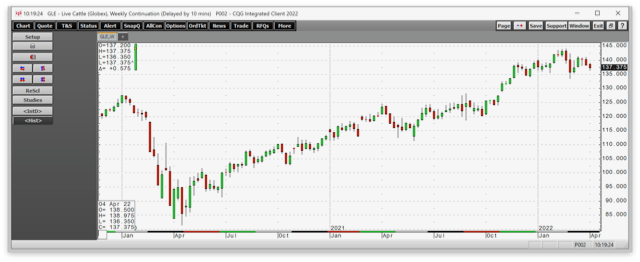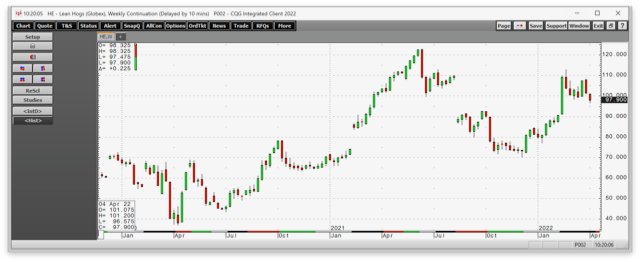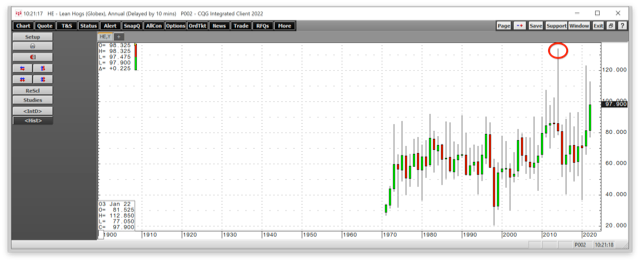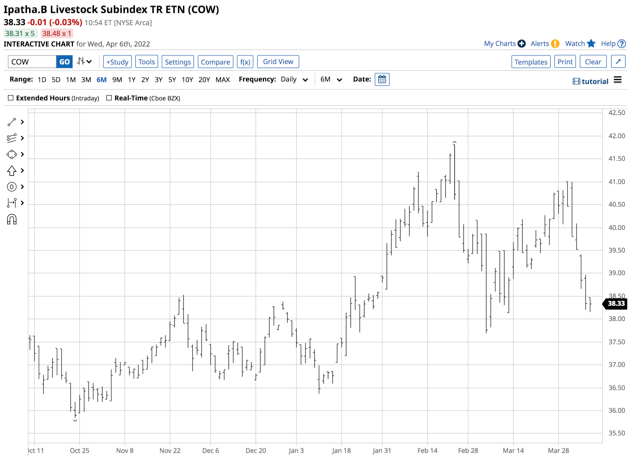This article was written exclusively for Investing.com
- Agricultural commodity prices rising
- Animal proteins trending higher
- Pork outperforming beef
- New record highs in hogs on the horizon
- COW ETN tracks meat prices
The US consumer price index showed that inflation rose by 7.9% in February, the highest level in more than four decades. Food and energy prices have exploded higher since the early 2020 pandemic-inspired lows.
During the height of the pandemic, cattle and hog prices diverged from reality. While live and feeder cattle futures fell to the lowest levels since 2009 and 2010, lean hogs did even worse, dropping to a price not seen since 2002. While producer prices plunged, consumers did not benefit as prices at the supermarket exploded higher because virus-related shutdowns at meat-packaging plants caused shortages and limits on purchases.
Cattle and hog prices have been trending higher since the 2020 lows. As the market heads into the 2022 peak grilling season, hogs are outperforming cattle, but both meat futures markets are rising.
Agricultural Commodity Prices Rising
Agricultural commodity prices have been soaring, seeing gains in 2021 and the first three months of 2022. A composite of grain prices rose 29.71% in 2021 and was 18.89% higher in Q1 2022. Soft commodity prices moved 31.57% higher in 2021 and added another 6.58% in the first quarter of this year.
Higher grain and food prices impact our grocery bills, and the other input costs for raising animals for meat. Ranchers and animal protein processors have seen their costs increase because of higher agricultural prices. Moreover, higher energy prices have put upward pressure on production costs. The energy composite rose 54.13% in 2021 and another 34.88% in Q1. Labor, equipment, and other input costs have soared, making cattle and hog production costs move to the upside. Market prices need to keep up with input costs for production to be economical.
Animal Proteins Trending Higher
The trend is always your best friend in markets because it reflects its sentiment. In the meats, the trends remain bullish in early April 2022, as the peak grilling season begins at the end of May and runs through early September.

Source: CQG
The weekly chart of live cattle futures highlights the pattern of higher lows and higher highs.

Source: CQG
The weekly feeder cattle chart reflects the upward bias of the beef market since the April 2020 low.

Source: CQG
Lean hog futures prices are also trending higher since the pandemic-inspired 2020, which sent wholesale pork prices to the lowest level since 2002.
Pork Outperforming Beef
In Q1 2022, live and feeder cattle futures posted declines. After rising 21.45% in 2021, live cattle futures edged 0.23% lower in Q1 2022. Feeder cattle futures moved 20.10% higher last year and declined 3.28% during the first three months of 2022.
Lean hogs were 15.94% higher in 2021 and added to the gains, with a 24.88% rally in Q1 2022. Rising inflation costs consumers a lot more each month for goods and services, and shoppers are wise consumers, substituting less expensive products to offset rising expenses. Pork may have rallied more than cattle in Q1 2022, but it remains cheaper per pound than beef, making pork chops and other pork products fit budgets more than steak and other beef products.
New Record Highs In Hogs On Horizon
The active month June lean hog futures contract highlights the steady rally in pork over the past months.

Source: CQG
The daily chart shows the bullish price action that took June lean hog prices to a high of $1.27325 per pound on Mar. 31 before correcting below the $1.15 level.

Source: CQG
The annual chart dating back to 1971 illustrates the all-time high in the lean hog futures market at $1.33875 per pound in 2014. The most recent high in June futures was 6.55 cents below the record peak. As the 2022 peak grilling season approaches, a challenge of the record high could be on the horizon.
COW ETN Tracks Meat Prices
The most direct route for a risk position in the meat markets is via the futures and futures options that trade on the Chicago Mercantile Exchange. The iPath® Series B Bloomberg Livestock Subindex Total Return (NYSE:COW) offers an alternative for those looking to participate in the cattle and hog markets without venturing into the highly leveraged and volatile cattle and hog futures arena.
At $38.33 per share on Apr. 6, COW had $28.294 million in assets under management. The ETN trades an average of 13,372 shares each day and charges a 0.45% management fee. The fund summary states:

Source: Barchart
The composite for live and feeder cattle and lean hog prices increased 7.12% in Q1 2022.

Source: Barchart
The COW ETN product moved from $37.67 on Dec. 31, 2021, to $39.80 per share on Mar. 31, 2022, a 5.7% gain.
The 2022 grilling season starts at the end of May. Animal protein producers are delivering cows and pigs to processing plants to meet the peak season demand. Higher feed prices will likely cause carcass weights to decline compared with previous years, creating supply shortages and higher prices.
I am bullish on beef and pork prices for the coming months. The trends in the cattle and hog futures arena are higher, and I expect them to continue to rise over the coming weeks and months. As pork becomes more expensive, consumers will likely turn back to beef, and meat prices will continue to make higher highs.
